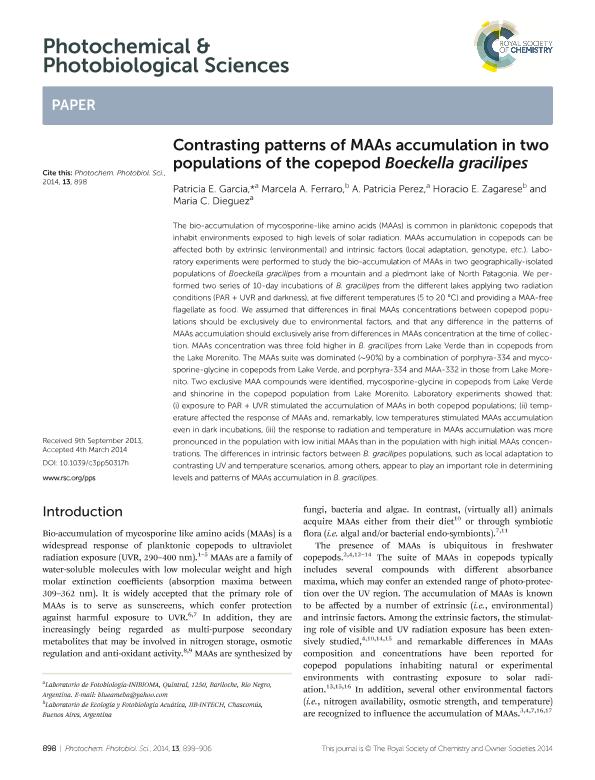Artículo
Contrasting patterns of MAAs accumulation in two populations of the copepod Boeckella gracilipes
Garcia, Patricia Elizabeth ; Ferraro, Marcela A.; Perez, Alejandra Patricia
; Ferraro, Marcela A.; Perez, Alejandra Patricia ; Zagarese, Horacio Ernesto
; Zagarese, Horacio Ernesto ; Dieguez, Maria del Carmen
; Dieguez, Maria del Carmen
 ; Ferraro, Marcela A.; Perez, Alejandra Patricia
; Ferraro, Marcela A.; Perez, Alejandra Patricia ; Zagarese, Horacio Ernesto
; Zagarese, Horacio Ernesto ; Dieguez, Maria del Carmen
; Dieguez, Maria del Carmen
Fecha de publicación:
2014
Editorial:
Royal Society Of Chemistry
Revista:
Photochemical And Photobiological Sciences
ISSN:
1474-905X
e-ISSN:
1474-9092
Idioma:
Inglés
Tipo de recurso:
Artículo publicado
Clasificación temática:
Resumen
The bio-accumulation of mycosporine-like amino acids (MAAs) is common in planktonic copepods that inhabit environments exposed to high levels of solar radiation. MAAs accumulation in copepods can be affected both by extrinsic (environmental) and intrinsic factors (local adaptation, genotype, etc.). Laboratory experiments were performed to study the bio-accumulation of MAAs in two geographically-isolated populations of Boeckella gracilipes from a mountain and a piedmont lake of North Patagonia. We performed two series of 10-day incubations of B. gracilipes from the different lakes applying two radiation conditions (PAR + UVR and darkness), at five different temperatures (5 to 20 °C) and providing a MAA-free flagellate as food. We assumed that differences in final MAAs concentrations between copepod populations should be exclusively due to environmental factors, and that any difference in the patterns of MAAs accumulation should exclusively arise from differences in MAAs concentration at the time of collection. MAAs concentration was three fold higher in B. gracilipes from Lake Verde than in copepods from the Lake Morenito. The MAAs suite was dominated (∼90%) by a combination of porphyra-334 and mycosporine-glycine in copepods from Lake Verde, and porphyra-334 and MAA-332 in those from Lake Morenito. Two exclusive MAA compounds were identified, mycosporine-glycine in copepods from Lake Verde and shinorine in the copepod population from Lake Morenito. Laboratory experiments showed that: (i) exposure to PAR + UVR stimulated the accumulation of MAAs in both copepod populations; (ii) temperature affected the response of MAAs and, remarkably, low temperatures stimulated MAAs accumulation even in dark incubations, (iii) the response to radiation and temperature in MAAs accumulation was more pronounced in the population with low initial MAAs than in the population with high initial MAAs concentrations. The differences in intrinsic factors between B. gracilipes populations, such as local adaptation to contrasting UV and temperature scenarios, among others, appear to play an important role in determining levels and patterns of MAAs accumulation in B. gracilipes.
Palabras clave:
Bioaccumulation
,
Maas
,
Boeckella Gracilipes
Archivos asociados
Licencia
Identificadores
Colecciones
Articulos(CCT - LA PLATA)
Articulos de CTRO.CIENTIFICO TECNOL.CONICET - LA PLATA
Articulos de CTRO.CIENTIFICO TECNOL.CONICET - LA PLATA
Articulos(IIB-INTECH)
Articulos de INST.DE INVEST.BIOTECNOLOGICAS - INSTITUTO TECNOLOGICO CHASCOMUS
Articulos de INST.DE INVEST.BIOTECNOLOGICAS - INSTITUTO TECNOLOGICO CHASCOMUS
Articulos(INIBIOMA)
Articulos de INST. DE INVEST.EN BIODIVERSIDAD Y MEDIOAMBIENTE
Articulos de INST. DE INVEST.EN BIODIVERSIDAD Y MEDIOAMBIENTE
Citación
Garcia, Patricia Elizabeth; Ferraro, Marcela A.; Perez, Alejandra Patricia; Zagarese, Horacio Ernesto; Dieguez, Maria del Carmen; Contrasting patterns of MAAs accumulation in two populations of the copepod Boeckella gracilipes; Royal Society Of Chemistry; Photochemical And Photobiological Sciences; 13; 6; 2014; 898-906
Compartir
Altmétricas



